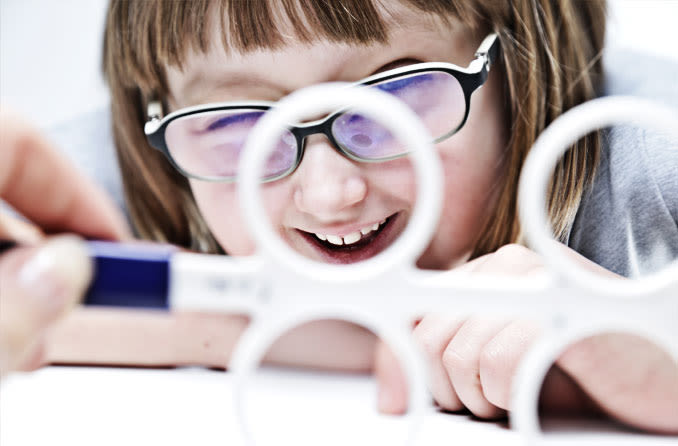What is (and isn't) vision therapy for children?

Vision therapy for kids is perhaps one of the most controversial topics in vision care.
Some eye doctors are strong advocates of vision therapy for children and testify to its benefit for certain vision problems. But other eye doctors are not convinced of vision therapy's effectiveness and do not recommend it.
This article will help you learn more about vision therapy so you can make an informed decision regarding its benefit for your child.
Vision therapy definition
Vision therapy is defined as a doctor-supervised, non-surgical and customized program of visual activities designed to correct specific vision problems and/or improve visual skills.
Unlike eyeglasses and contact lenses that compensate for vision problems, or eye surgery that alters the anatomy of the eye or surrounding muscles, vision therapy aims to "teach" the visual system to correct itself.
Vision therapy is like physical therapy for the entire visual system.
Vision therapy can include the use of lenses, prisms, filters and video games. Other devices, such as balance boards & metronomes, can play an important role in a customized vision therapy program.
It is important to note that vision therapy is not defined by a simple list of tools and techniques. Successful vision therapy outcomes are achieved through a therapeutic process that depends on the active engagement of the prescribing doctor, the patient and (in the case of children) the child's parents.
Overall, the goal of optometric vision therapy exercises should be to treat vision problems that cannot be treated successfully with eyeglasses, contact lenses and/or surgery alone, and to help people achieve clear, comfortable binocular vision.
Many studies have shown that one benefit from vision therapy can correct vision problems that interfere with efficient reading among school children. It also can help reduce digital eye strain and other symptoms of computer vision syndrome experienced by many children and adults. See below for more on conditions treated with vision therapy.
Vision therapy is also known as...
Vision therapy is sometimes called visual therapy, vision therapy training, visual training or simply VT.

Vision therapy can correct vision problems that interfere with efficient reading.
Another name often associated with vision therapy is "orthoptics." This term, which literally means "straightening the eyes," dates back to the 1850s. However, it is limited to techniques for training eye muscles for the purpose of cosmetically straightening eyes that are misaligned (vision therapy for strabismus) and binocular vision therapy.
Orthoptics can be very successful and is one type of vision training, but the term "orthoptics" is not synonymous with "vision therapy," which describes a broader range of techniques used to treat a wider variety of vision problems.
The emphasis in orthoptics is on eye muscles and eye alignment (at least cosmetically). The goal of vision therapy is to optimize the entire visual system, including the eyes and areas of the brain that control vision, visual perception and other vision-related functions. By treating the entire visual system, vision therapy aims to change reflexive (automatic) behaviors to produce a lasting cure.
In many cases of strabismus, vision therapy can be a better treatment choice than surgery. In other cases, it can be a beneficial adjunct therapy before and after surgery to increase the likelihood of a successful outcome.
Most vision therapy performed in the United States is prescribed and monitored by an optometrist. For this reason, it is also called optometric vision therapy.
Optometrists who specialize in vision therapy — especially those who also specialize in children's vision and vision development — may call themselves pediatric optometrists, behavioral optometrists or developmental optometrists.
The science behind vision therapy
You've probably heard the old adage, "You can't teach an old dog new tricks." But recent research in the field of neurology suggests that when it comes to the human brain, that's not true. It just may take a little more time and effort.

Vision therapy and sports vision training can improve vision skills needed for sports.
Studies show that the human brain has a significant amount of neuroplasticity — the ability to change its structure and function in response to external stimuli. And these neurological changes in the brain, once thought to occur only during early childhood, have been demonstrated to occur in adults as well.
Recent findings about neuroplasticity appear to confirm what many vision therapy experts have been saying for years: Properly devised and administered programs of vision therapy can cause neurological changes that correct vision problems and improve visual performance.
Some experts say certain anomalies associated with vision development, visual perception or vision function may be affected by neuroplasticity. If this is true, it's likely these same vision problems may be successfully treated with vision therapy.
Problems vision therapy can correct
Vision problems being treated with vision therapy include:
Amblyopia. Also called "lazy eye," amblyopia is a vision development problem in which an eye fails to attain normal visual acuity, usually due to strabismus or other binocular vision problems. Specially designed video games are a recent form of vision therapy being shown to improve visual development among children with amblyopia.
Strabismus. The success of vision therapy for strabismus depends on the direction, magnitude and frequency of the eye turn. VT has been proven effective for treating an intermittent form of strabismus called convergence insufficiency, which is a failure to keep the eyes properly aligned when reading despite appropriate alignment when looking at distant objects.
Other binocular vision problems. Subtle eye alignment problems called phorias (esophoria) that may not produce a visible eye turn but still can cause eye strain and eye fatigue when reading also can be minimized or corrected with vision therapy.
Eye movement disorders. Studies have shown vision therapy can improve the accuracy of eye movements used during reading and other close-up work.
Accommodative (focusing) disorders. Other research shows near-far focusing skills can be improved with vision training.
Other problems. Other vision problems for which vision therapy may be effective include visual-perceptual disorders, vision problems associated with developmental disabilities and vision problems associated with acquired brain injury (such as from a stroke).
What vision therapy isn't
Vision therapy is not the self-help vision improvement programs advertised with the promise that you can "throw away your glasses" after performing a series of eye exercises.
Self-help vision improvement programs are not endorsed by the American Optometric Association or other professional eye care organizations. There is no scientific research that supports the claim that "self-help" eye exercises can reverse nearsightedness or other refractive errors.
It's also important to know that a home-based regimen of "pencil push-ups," even when recommended by an eye doctor, should not be considered a complete program of vision therapy.
Pencil push-ups — an orthoptic activity in which a person looks at small print on a pencil held at arm's length, and then slowly moves the pencil closer to his or her eyes while maintaining focus on the letters — is a task sometimes recommended for people to perform at home to decrease eye strain and other symptoms caused by convergence insufficiency (CI).
While an eye doctor may recommend pencil push-ups at home as a low-cost treatment for convergence insufficiency, studies suggest a supervised in-office program of vision therapy plus reinforcement orthoptic exercises performed at home is the most effective non-surgical treatment for this vision problem.
Sports vision training
Sports vision training is not vision therapy, but it shares some of the characteristics of VT. Optometrists and ophthalmologists who specialize in sports vision offer customized vision training programs for anyone interested in optimizing their visual skills for specific sports.
Many Olympic and professional athletes have undergone sports vision training programs to improve their performance.
Sports vision training programs are designed to enhance a person's visual skills for a specific sport rather than to correct a vision problem, the term "vision training" is preferred over "vision therapy." However, some of the techniques used in sports vision training are similar to those used in vision therapy.
Vision therapy for dyslexia and other learning disabilities
The relationship between vision problems and learning disabilities is a hotly debated topic and one which optometrists and ophthalmologists often have different opinions. For instance, studies have shown little to no evidence for the effectiveness of vision therapy for dyslexia.
Many optometrists support the use of vision therapy as part of a versatile approach to the treatment of certain types of learning disabilities. They contend that, in many cases, children with learning disabilities also have underlying vision problems that may be contributing in some degree to their learning problems.
It's possible, they say, that these learning-related vision problems may be successfully treated with optometric vision therapy to improve the child's overall capacity for learning.
Many ophthalmologists feel vision therapy is ineffective in treating any type of learning problem and say there is no scientific evidence to support the claim that the correction of vision problems reduces the severity of learning disabilities.
A pediatric eye exam is the first step
If you think your child has a vision or visual problem that may be affecting their performance in school or sports, the first step is to schedule a routine eye exam to rule out nearsightedness, farsightedness and/or astigmatism.
If the basic eye exam suggests that no glasses are needed, or there is no change in your child's current eyeglasses prescription, or each eye has 20/20 visual acuity, be aware that a vision problem still may exist. The eye chart used in routine eye exams tests only a person's distance vision and does not test all critical aspects of visual performance.
For a thorough analysis of your child's vision that evaluate vision skills needed for efficient reading and learning, consider scheduling a comprehensive eye exam with a children's eye doctor near you who specializes in vision therapy, binocular vision and/or vision development.
At the end of the comprehensive exam, the doctor should give you a detailed assessment of your child's vision and visual skills. If vision problems are identified and a program of vision therapy is recommended, be sure to get information about the likely duration of the therapy and success rates for the specific type of vision therapy being recommended.
Also, ask what criteria are used to define "successful" treatment.
Request details about the expected cost of the therapy program, and whether any of the costs will be covered by your vision insurance policy. In many cases, vision therapy is not a covered benefit in insurance programs.
Page published on Wednesday, February 27, 2019




